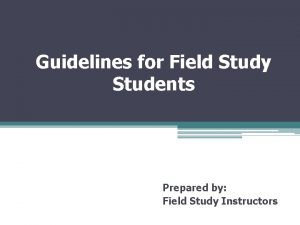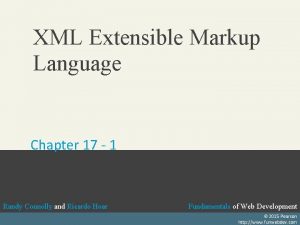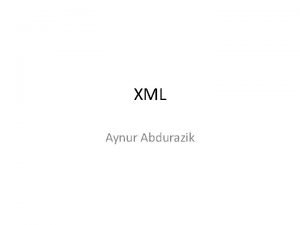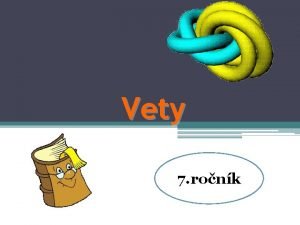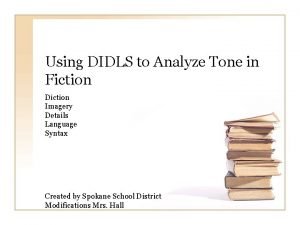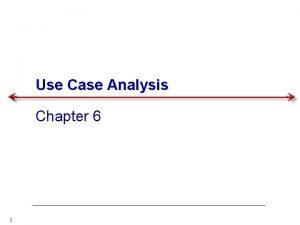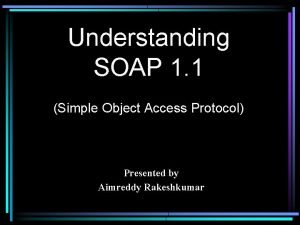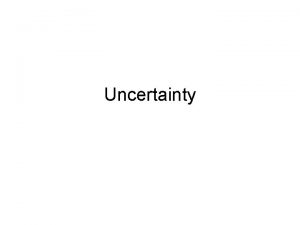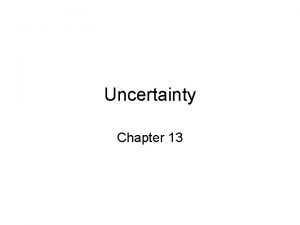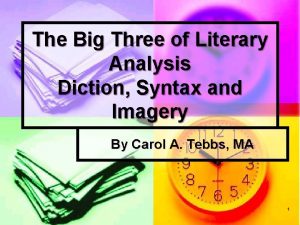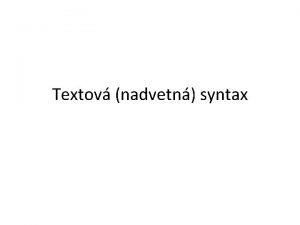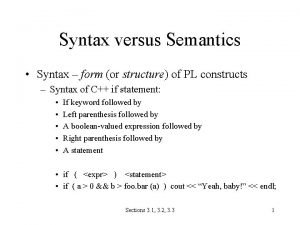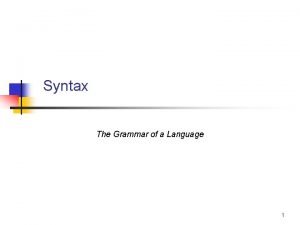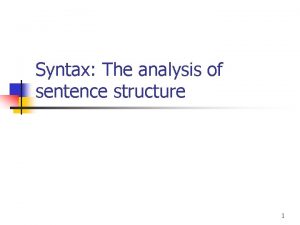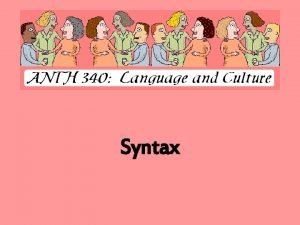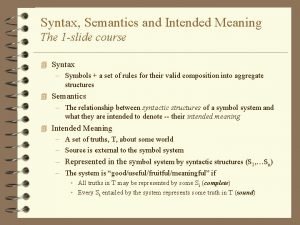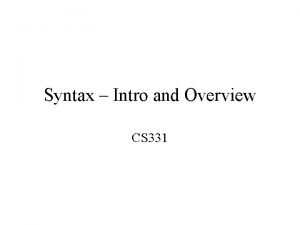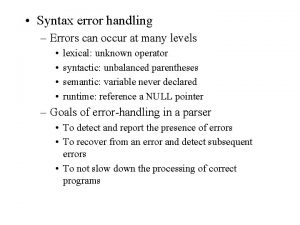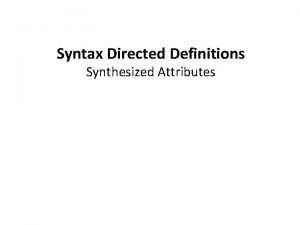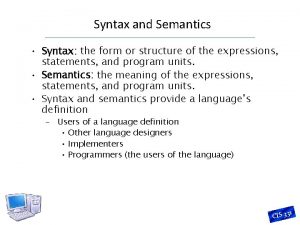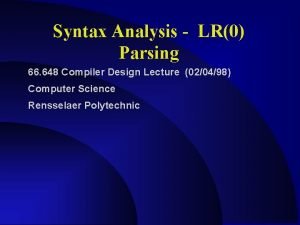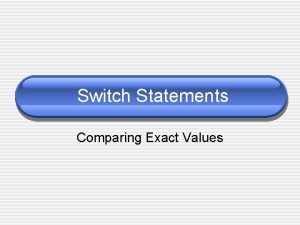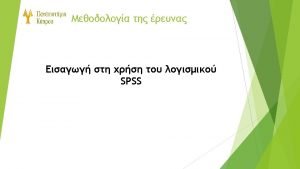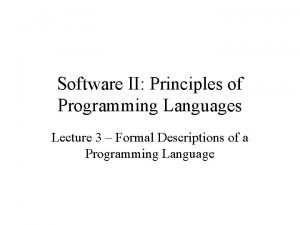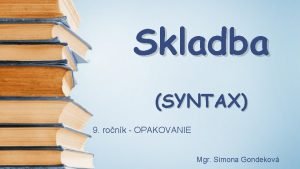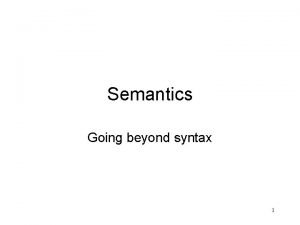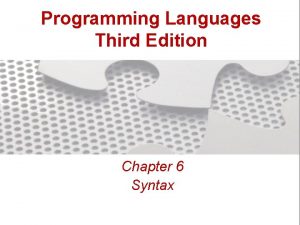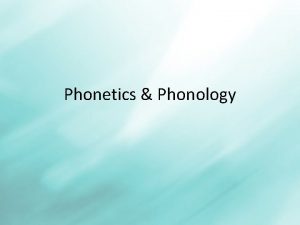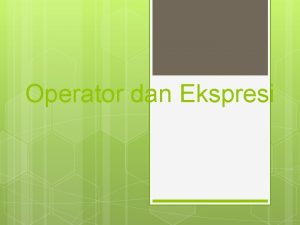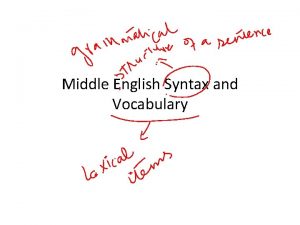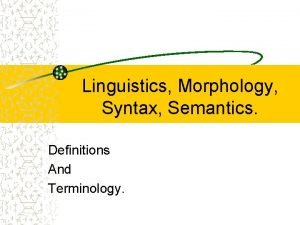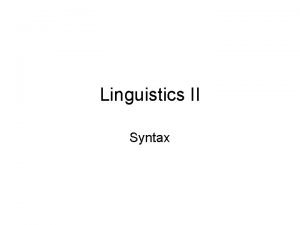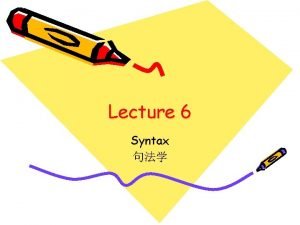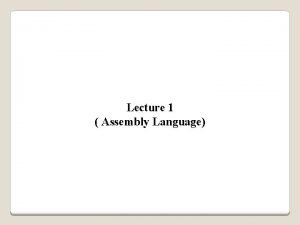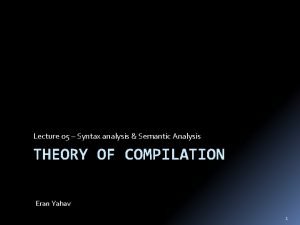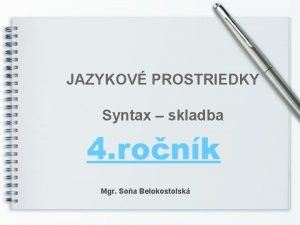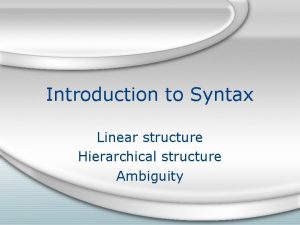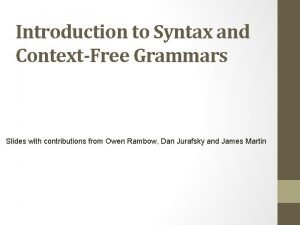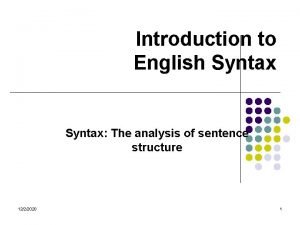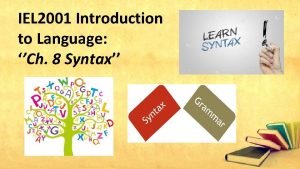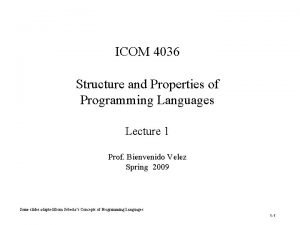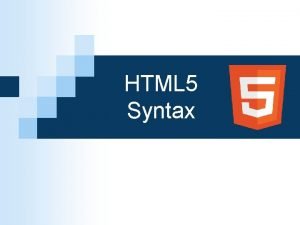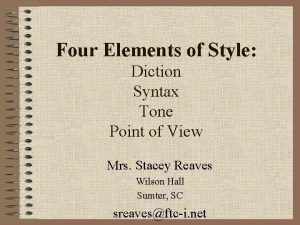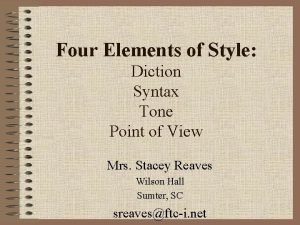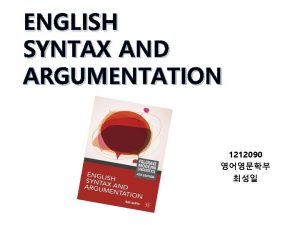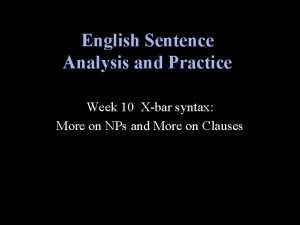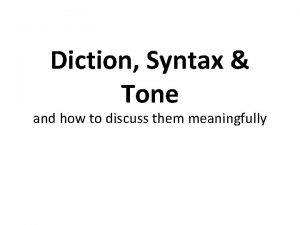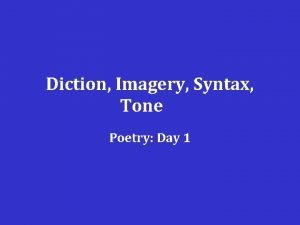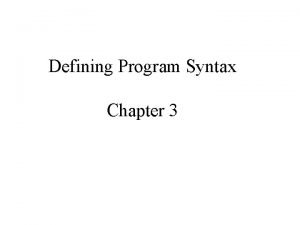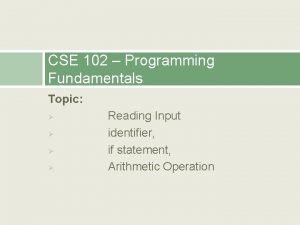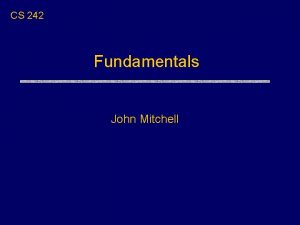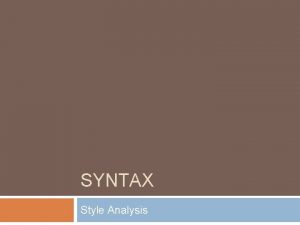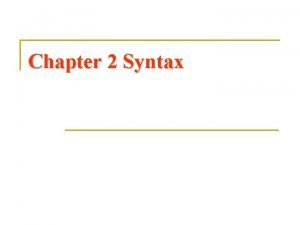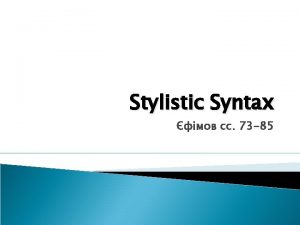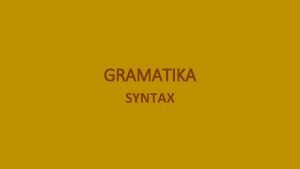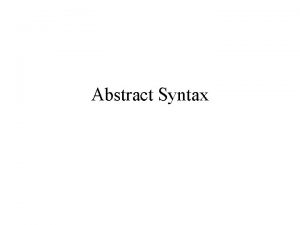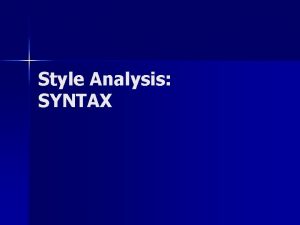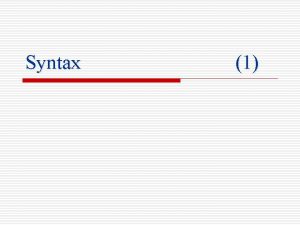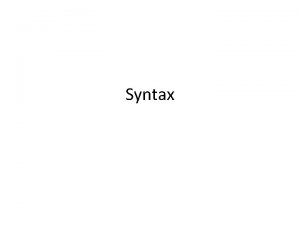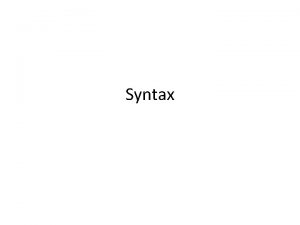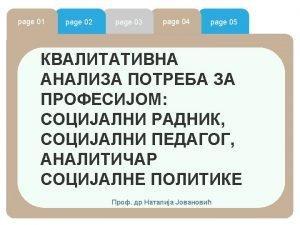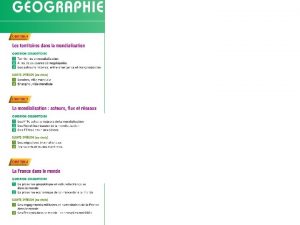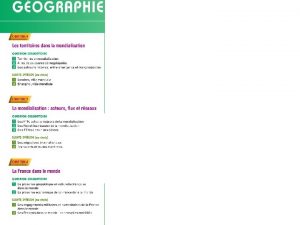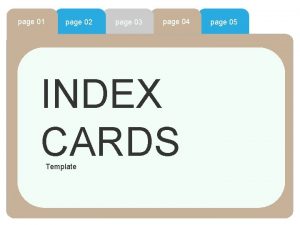SYNTAX page 72 A study In an AP










































































- Slides: 74

SYNTAX (page 72) A study In an AP rhetorical category: Sentence structure, conventions, and language

Rhetorical Analysis The purpose of rhetorical analysis is to determine how an author uses language to create meaning, develop his or her purpose(s) and/or produce particular effects.

A Rhetorical Category (pg 20) Diction (modifiers) Formal, didactic, slang, colloquial, academic, abstract Syntax (parallel structure, coordination, loose/periodic…) Figurative Language (simile, metaphor, motif, symbol) Point of View Organization Details

CAUTION! Understanding the author’s meaning/purpose is ESSENTIAL and the fundamental goal! Who cares if you can find rhetorical “stuff” but do not know how it contributes to the meaning of the piece?

Step 5: analyze If you are talking about what the text says, you are summarizing. If you are talking about how the text makes meaning, you are analyzing.

Purpose & Effect of Devices Why does this writer choose this particular strategy to create his or her message? How does the writer use this strategy to make meaning? Why does the writer use this particular strategy and this particular example? Because the writer used this rhetorical strategy, how/why does the use influence one or more of the following: Speaker Reader Message Tone Purpose

Rhetorical Focus: SYNTAX

SYNTAX Page 71 You will need several sticky notes


SYNTAX The way words & clauses are arranged to form sentences. The arrangement contributes to, and enhances, meaning and effect. The way author’s put words & phrases together. Helps author’s make their point more effectively.

Scope & Sequence Now: Persuasion: 4 basic sentence types Anaphora Coordination Antithesis Subordination Inductive and Deductive Loose & Periodic Sentences Parallel structure Inverted syntax Repetition Rhetorical questions logic and organization RQ & Simple Sentences Understatement Restatement

When analyzing SYNTAX, consider first: Position – Where the author puts something in the sentence Isolation – Setting x off by itself (dash, quotation marks, parenthesis, etc. ) Repetition – The number of times something is repeated Proportion – The size of the idea and how much of the piece the idea takes up Length of sentences Unconventional punctuation

The Basic Sentence Types

Basic Sentence Types Interrogative Sentence Question Imperative Sentence Command Declarative Sentence Statement Exclamatory Sentence Exclaim/excitement

Sentence Type & Variety Binder (notes) Page 73


A Simple Sentence independent clause, contains a subject and a verb (for us, a DO, too!) expresses a complete thought

Purpose/Effect of Simple Sentences PURPOSES Consider: How does this sentence compare to others by which it is surrounded? Disrupts pace and rhythm Creates a sense of unbalance Reflects rapid movements; reader feels tension of narrator Emphasizes the main clause (simple sentence subject) Answer a rhetorical question (which cannot be answered) EFFECTS Why does this subject or clause need to be emphasized? Why does balance need to be broken? Indication of power (stops momentum) – now, consider what is more powerful than the surrounding subjects Ethos appeal – when answering a rhetorical question; how and why?

A Compound Sentence Two independent clauses joined by a coordinator and/or coordinating conjunction (and a comma) The first letter of each of the coordinators spells FANBOYS for, and, nor, but, or, yet, so put a comma before the coordinating conjunction because there are 2 independent clauses being combined

Coordination • Use coordinating conjunctions: and, but, for, nor, yet, and so. The andcat therubbed cat tie. , The dog ate Marvin’s favorite tie rubbed white hair on Marvin’s black suit. Both clauses could stand alone. When joined with and, they get equal attention.

You can also coordinate with a semicolon. Main cl ause +; + main clause. Main cl ause +; + transition +, + m ain mai n clause. c laus e. The interviewer had seven Persian cats; She she as would a result, she. Marvin’s would understand Marvin’s predicament. understand would understand Marvin’s predicament. Still balanced.

Diagramming Compound Sentences

Compound Purpose/Effect of Coordinated Sentences PURPOSES Give equal attention to 2 items or subjects Creates balance and unity One idea is not emphasized over another Provides increased momentum in the text (no choppy sentences) Can also slow down the pace EFFECTS Consider why are x and y made equal? What does the rhythmic pattern (momentum) parallel, mirror, create or support?

A Complex Sentence independent clause joined by one or more dependent clauses always has a subordinator such as because, since, after, although, or when or a relative pronoun such as that, who, or which

Subordinate Conjunctions § § § § § after although as because before even though if, even if in order that once provided that § § § § § since so [that implied], so that than that though unless when, whenever where, wherever, whereas whether while

Subordination • Subordination gives less attention to one idea so that the other has emphasis. • Use subordinate conjunctions, such as because, even though, and when. Since Marvin tried tohis clean late to Marvin tried to clean suit. his Hesuit was, he latewas to the interview. I’m sorry.

Use a comma if you subordinate the first of the two clauses. Subordinate clause +, + main clause. Even though hair clung Marvin’s pant Cat hair clung tocat Marvin’s panttolegs. He still got the legs, he still got the job. The first clause is less important. The second clause has more emphasis because its thought is complete.

Use no punctuation if you subordinate the second of the two clauses. Main clause +Ø+ subordinate clause. Marvin smiled at his success. Cat ashair cat wafted hair wafted in his wake. Now the first clause is the most important. The second clause has less emphasis because its thought is incomplete.

Sample Item A. Jeremiah forgot to bring a pencil since he had to beg Amanda to borrow one of hers. B. Since Jeremiahforgottoto bring a pencil, he he had to beg. Amandatotoborrow one of of hers. C. Even though Jeremiah forgot to bring a pencil, he had to beg Amanda to borrow one of hers. Subordinating Is the first clause subordination with since, as effective at A, option B does, B, or C? is correct.

Purpose/Effect of Complex Sentences PURPOSES Emphasizes one idea and subordinates another idea The clause following the subordinator will be less important Used in argument Tone academic or pretentious, sarcastic Can show train of thought or existential thinking Show high emotion or lack of emotion EFFECTS Increase ethos appeal Showing awareness of the opposition Discuss why subject being emphasized appeals to audience How emphasis supports the claim of text

Subordination

subject verb Subordinating conjunction

A Quick Recap Coordination & Subordination

Coordination writer places concepts or people or objects on an equal level and joins them with conjunctions versus Subordination The writer states the more important idea in an independent clause (a group of words with a subject and a verb that express a complete idea) and the less important idea in a dependent clause

Diagramming with Conjunctions

Independent Practice Page 74 – 76 and 79

Review: Rhetorical Effects of Sentence Length Pacing change (speed up/slow down) Emphasize a main clause Emphasize the details connected to a main clause Create sense of balance Show equal relationship b/w ideas Show unequal relationship b/w ideas Create a sense of unbalance/chaos

Of Plymouth Plantation Coordination and Subordination in Early American Writing

But that which was most sad and lamentable was, that in two or three months’ time half of their company e died, especially in January and February, being in the h t r e d i s n depth of winter, . and other Cowanting houses 1 f o comforts; being infected with the scurvy and other t x e t n o c diseases which this long voyage and their ” h t u o m y inaccomadate position had brought upon them. So as l h “P p a r g a r their died sometimes two or three a day in the foresaid a p s i _ h _ T _. 2 odd persons, a time, that of 100 and scarcely fifty h t i w s n ? i y remained. And of these, of most distress, h w begin the time … n o i t there was but six or sevenjusound persons who to their c n ? t n c o e c f f great commendations, be it spoken, spared no pains E ? e s o p r night nor day, but with abundance of toil and hazard of u P. 3 their own health, fetched them wood, made them fires, dressed them meat, made their beds, washed their loathsome clothes, clothed and unclothed them.

Analysis Chart: (page 77) Syntactical Element Textual Example Coordination/ Example 1 (prior Coordinated Sent. to shift, first part of Structure shift/contrast) Coordination/ Example 2 (after Coordinated Sent. shift, 2 nd part of Structure shift/contrast) Purpose of Device (effect? ) Effect of Device Connection to UT

Sentence Logic Loose and Periodic Sentence Structures To Come: Inductive and Deductive Logic & Organization

General Purpose/Effects of “Longer” Sentences Increased number of words necessary to provide definitions and context Legal and political subjects Jargon (diction) Depends on modification for accuracy Ethos appeal Narrowing of audience or increasing audience Tone: pretentious, stream of consciousness Fiction/narrative: increase description of subject Effect: consider why this subject is emphasized or described in a particular way Increase suspense

Loose Sentence Type of sentence in which the main idea (independent clause) comes at the beginning of the sentence The main idea (clause) is followed by successive addition of details via a coordinate or subordinate phrase/clause

Examples of the Loose Sentence: Basic statement: Bells rang. Loose sentence: Bells rang, filling the air with their clangor, startling pigeons into flight from every belfry, bringing people into the streets to hear the news. Basic statement: The teacher considered him a good student. Loose sentence: The teacher considered him a good student, steady if not inspired, willing if not eager, responsive to instruction and conscientious about his work.

The Periodic Sentence The sentence is not complete until the final phrase/clause. “suspended syntax” Usually has an emphatic climax The main clause/subject is placed at the very end of the sentence.

Examples of the Periodic Sentence: In this sentence, additional details are placed before the basic statement. Delay, of course, is the secret weapon of the periodic sentence. Basic statement: John gave his mother flowers. Periodic sentence: John, the tough one, the sullen kid who scoffed at any show of sentiment, gave his mother flowers. Basic statement: The cat scratched Sally. Periodic sentence: Suddenly, for no apparent reason, the loveable cat scratched Sally. Basic statement: Love is blind. Periodic sentence: Love, as everyone knows except those who happen to be afflicted with it, is blind.

Purpose/Effect of Loose & Periodic Sentences Loose Sentences Structure is easier, simpler, more natural & direct Emphasis on the subject of the main clause Periodic Sentences More complex, emphatic, formal or literary Emphasis can be on details or main clause at the end of the sentence Builds suspense

Parallel Structure

What is Parallel Structure? Grammatical/structural similarity between sentences or parts of a sentence. Balanced arrangement of words, phrases, sentences, and/or paragraphs

Simple Parallel Structure Simple Parallel: She looked tired, frustrated, and disgusted. The three underlined words are arranged in a series of coordinated elements. These elements all have the same form and the same grammatical function (adjectives which in the sentence serve as complements). Because of this similarity of form and function, they are said to be parallel. Purpose: to show that the girl is equally showing all 3 qualities. Why is this stronger than demonstrating one quality? )

Complex Parallel Structure “Robert E. Lee was a foe without hate, a friend without treachery, a soldier without cruelty…” (Canton) This sentence goes beyond simple combining and achieves rhythm and cadence through the deliberate repetition of parallel elements. Extend: what is the effect of creating cadence?

Purpose/Effect of Parallel Structure Purpose Creates balance or unity Creates a rhythm equally developed importance and similarity within/among phrased context Effects Balance between what subjects? Consider connect to subject, message, purpose/UT Rhythm – connect to medium; paralleling the subject?

Next morning when the first light came into the sky and the sparrows stirred in the trees, when the cows rattled their chains and the rooster crowed and the early automobiles went whispering along the road, Wilbur awoke and looked for Charlotte.

“I have a dream that one day this nation will rise up and live out the true meaning of its creed: "We hold these truths to be self-evident: that all men are created equal. " I have a dream that one day on the red hills of Georgia the sons of former slaves and the sons of former slave owners will be able to sit down together at a table of brotherhood. I have a dream that one day even the state of Mississippi, a desert state, sweltering with the heat of injustice and oppression, will be transformed into an oasis of freedom and justice. I have a dream that my four children will one day live in a nation where they will not be judged by the color of their skin but by the content of their character. I have a dream today. ” (King)

Parallel Structure “The manor— designed for beauty and grace, built for durability and strength, and located for privacy and safety – was the ideal home for those three children. ” Purpose? Cadence and rhythm Balance and unity (of? ) Effect: Tone of harmony Do the characteristics reflect children of the house? #3 – holiness?

Of Plymouth Plantation: Style Marker “…they had now no friends to welcome them nor inns to entertain or refresh their weather-beaten bodies; no houses or much less towns to repair, to seek for succor. ” Purpose? Effect?

Analyzing Syntax Graphic Organizer Syntactical Element Textual Example Syntactical Element Example 1 (prior to shift, first part of shift/contrast) Syntactical Element Example 2 (after shift, 2 nd part of shift/contrast) Purpose of Device Effect of Device (effect? ) Connection to UT

Juxtaposition

A Definition of Juxtaposition placing close together or side by side, especially for comparison or contrast

Consider this Scenario: Let's take a situation from any generic film. A very poor woman gives birth to twins and dies immediately after. The sons get separated at birth. While one son finds himself adopted into a wealthy factory owner's house, the other is a street child who turns into a petty thief. The film story traces their journey through life. At a crucial moment, the son who is a petty thief corners the other son in a dark alley and mugs him. Thus a juxtaposition is drawn here which shows the contrast that both sons, born of the same mother and identical to look at, are yet so much different in their motives, lifestyles and characters. Thus the literary device of juxtaposition is used to draw a contrast between the two, but it is still connected somewhere and it is possible to place them side by side to draw a contrast.

Juxtaposition Examples "Sliding Doors" trailer There are varied examples that one can go on to explain the concept of juxtaposition like Christina Aguilera's video 'Beautiful' which shows an anorexic girl or Louis Armstrong's song 'What a Wonderful World' which has images of violence and war running throughout the length of the video.

Basic Literary Examples for Juxtaposition This was the culture from which I sprang. This was the terror from which I fled. (Black Boy) He slouched gracefully.

Inverted Syntax

Definition: inverted word order Emphasize the subject Emphasize the predicate Conform to literary conventions Style marker for Puritan style (plain style) Why would the speaker want subject x or subject y emphasized? Why would the speaker want predicate x or predicate y emphasized? Consider how the emphasize supports the author’s message or UT. How does this subject resonate with an intended audience?

The Rhetorical Question …and their rhetorical effects

Interrogative Sentence Asks a question that expects or requires an answer from the audience Rhetorical Question Makes a questioning statement that does not expect an answer Put this in commentary!

Purpose/Effect of Rhetorical Questions Purpose Effects Question intended to make a How does subject identify the point – consider subject of the question Reflection Contemplation Existential thinking Confusion intended audience? How does the common tones connect to subject?

Rhetorical Questions & Persuasion When followed with a simple sentence, speaker creates ethos appeal The nature of a RQ is that it cannot be answered But the speaker is able to answer this question Tone – knowledgeable and credible, fearless leader

Repetition

Repetition Definition the simple repeating of a word, within a sentence or a poetical line, with no particular placement of the words Purpose/Effect Emphasis of ideas Building of momentum Refocusing of reader to subsequent important ideas Adds conviction to what is being said; is really effective in speeches desperation

Passive versus Active Voice

Passive Voice The subject does not act The subject is acted upon Always uses an is verb & a past participle Active Voice A sentence is in the active voice when the subject does the acting instead of being the recipient of the acting

Basic Examples Passive The portfolio piece was prepared by the student. There was also found two of their [the Indians’] houses covered with mats, and sundry of their implements in then, but the people were run away and could not be seen. Active The student prepared the portfolio piece. How would you rewrite the second example using active voice?

Purpose/Effect of Active & Passive Voice Often used in bureaucratic or political prose – why? Gentler, more diplomatic approach, cowardly? Emphasizes what was found, not who did the finding Can be pedantic and wordy sounding – confusing to audience? (speech) Hides who was responsible for the action Strengthens the degree of objectivity Active Voice Natural diction The subject is front and center, as is what its doing Often uses stronger verbs because emphasis is on verbs Clearly defined actor and action More forceful, greater clarity
 Syntax directed translation scheme
Syntax directed translation scheme Psychology title page
Psychology title page Why do we study syntax
Why do we study syntax Introduction to field study 1 in education
Introduction to field study 1 in education What is case series
What is case series Retrospective cohort study
Retrospective cohort study Critical examination in method study
Critical examination in method study Study less study smart
Study less study smart In area
In area Distinguish between time study and motion study
Distinguish between time study and motion study Difference between time study and motion study
Difference between time study and motion study Xml usage
Xml usage Dtd syntax
Dtd syntax Zvolacie vety
Zvolacie vety Didls tone
Didls tone Use case syntax
Use case syntax Understanding soap
Understanding soap Probability syntax
Probability syntax Probability syntax
Probability syntax Syntax and diction
Syntax and diction Textová syntax
Textová syntax Semantics vs syntax
Semantics vs syntax Syntax vs grammar
Syntax vs grammar Structural ambiguity examples
Structural ambiguity examples Syntax rules definition
Syntax rules definition Syntax symbols and meanings
Syntax symbols and meanings Me up at does
Me up at does Syntax vs semantic
Syntax vs semantic Syntax error handling
Syntax error handling Syntax directed defination
Syntax directed defination Syntax vs semantics
Syntax vs semantics Syntax analysis in compiler design
Syntax analysis in compiler design Syntax in the things they carried
Syntax in the things they carried What are switch statements in c
What are switch statements in c Spss syntax editor
Spss syntax editor Parse tree for if else statement
Parse tree for if else statement Prisudzovací sklad príklady
Prisudzovací sklad príklady Syntax vs semantic
Syntax vs semantic Syntax programming
Syntax programming Inverted syntax
Inverted syntax Syntax and grammar
Syntax and grammar Pseudo code syntax
Pseudo code syntax Basic syntax in java
Basic syntax in java Ekspresi aritmatika
Ekspresi aritmatika Nlp syntax
Nlp syntax Examples of syntax
Examples of syntax Middle english syntax
Middle english syntax What is syntax literary device
What is syntax literary device What is morphology in linguistics
What is morphology in linguistics Syntax rules
Syntax rules Ic analysis example
Ic analysis example What can you do with assembly language
What can you do with assembly language Syntax vs semantics
Syntax vs semantics Parsing syntax
Parsing syntax Jazykové konektory
Jazykové konektory The hierarchical structure of sentences
The hierarchical structure of sentences Syntax vs grammar
Syntax vs grammar Lexical category
Lexical category Differences between morphology and syntax
Differences between morphology and syntax Syntax tree diagram adverb phrase
Syntax tree diagram adverb phrase Algol syntax
Algol syntax Html 5 syntax
Html 5 syntax Patterns of diction
Patterns of diction Ways to describe diction
Ways to describe diction English syntax and argumentation
English syntax and argumentation X bar theory practice
X bar theory practice Early modern english syntax
Early modern english syntax Syntax xml
Syntax xml Diction vs syntax
Diction vs syntax Syntax vs diction
Syntax vs diction Negative diction
Negative diction Diction vs syntax
Diction vs syntax What is syntax in programming example
What is syntax in programming example Scanf syntax in c
Scanf syntax in c Syntax vs semantics
Syntax vs semantics



